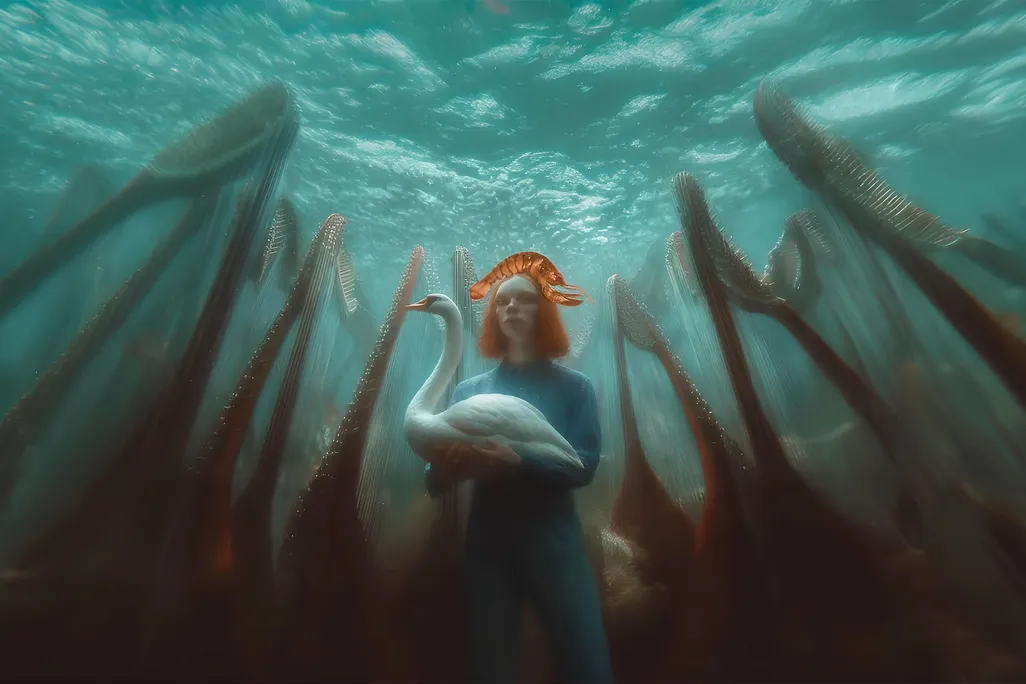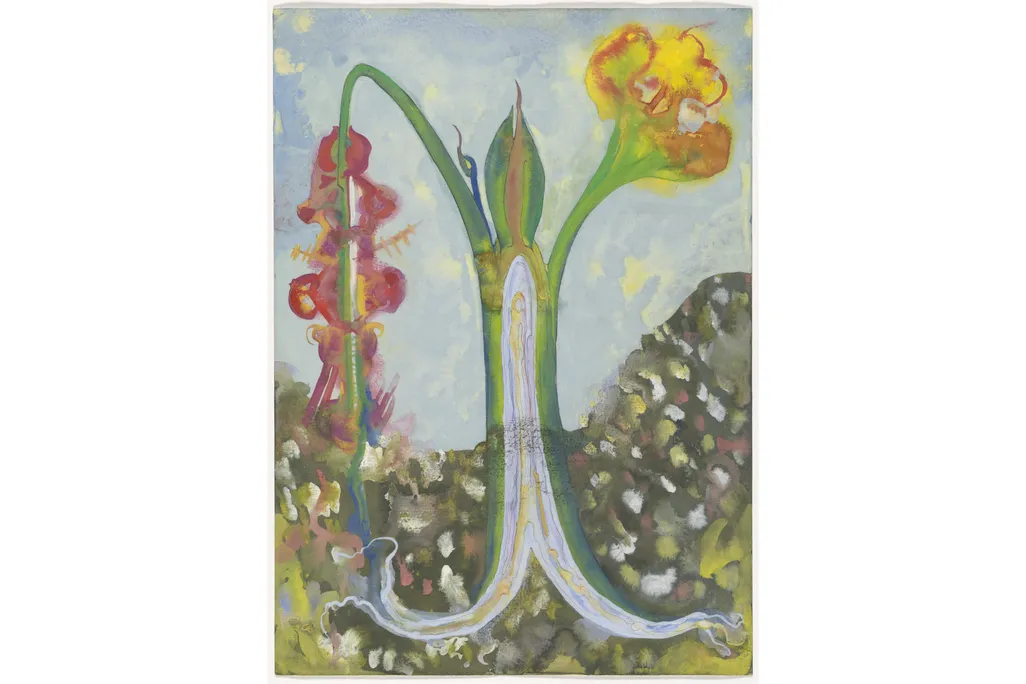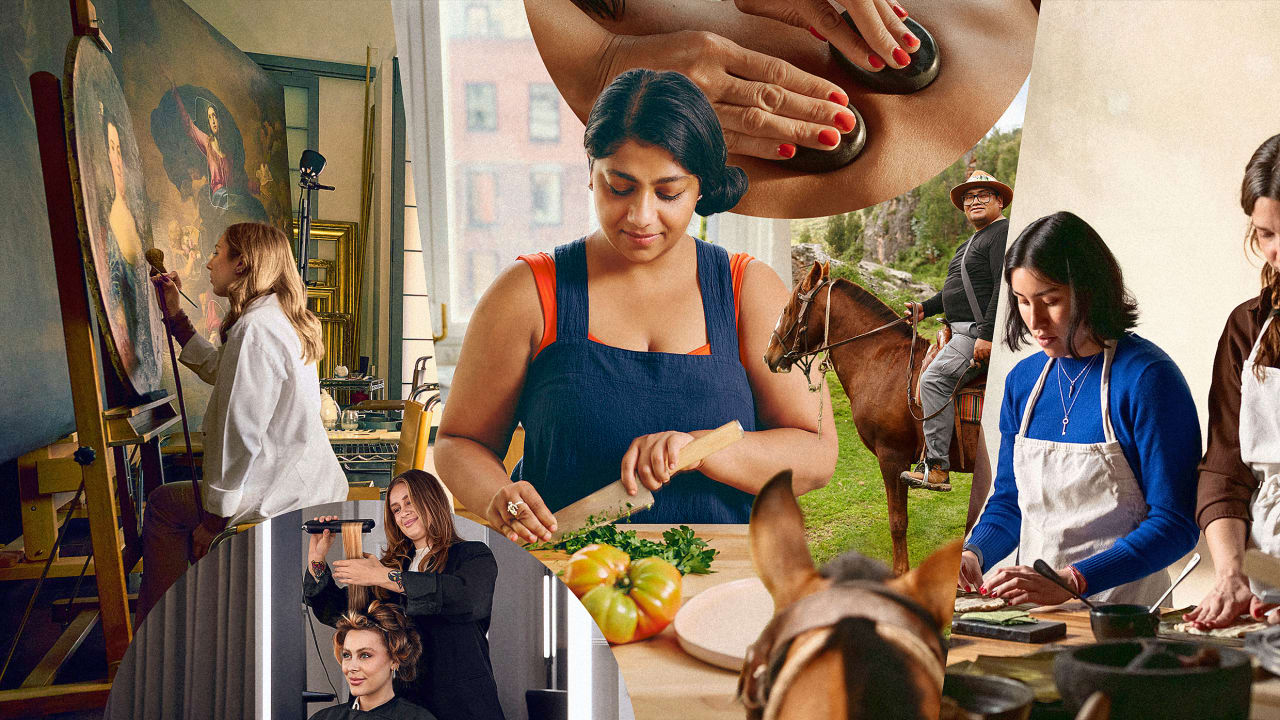Salvador Dalí's Surrealist Screenplay 'Giraffes on Horseback Salad' Was Never Made. Can A.I. Bring It to Life?
Salvador Dalí’s Surrealist Screenplay ‘Giraffes on Horseback Salad’ Was Never Made. Can A.I. Bring It to Life?
The Dalí Museum is collaborating with an advertising agency to “reawaken” the Spanish artist’s failed script, which studio executives rejected nearly 90 years ago
A still from the Giraffes on Horseback Salad trailer
Goodby Silverstein & Partners
In 1937, Salvador Dalí conceived of a movie that would star the Marx Brothers against a bizarre, romantic dreamscape filled with animals and fire. But when the Spanish artist brought his drawings and notes for Giraffes on Horseback Salad, as he called it, to Metro-Goldwyn-Mayer, the studio decided it would be impossible to produce.
Now, nearly 90 years later, Dalí’s abandoned film is finally coming together—produced not by MGM, but by artificial intelligence.
The Dalí Museum in Florida is partnering with Goodby Silverstein & Partners, a San Francisco-based advertising agency, to bring the project to life using Dalí’s surviving notes and Google’s A.I. tools. While the film is still in development, a trailer was released on YouTube in April.
“Salvador Dalí said that he would be remembered for the words he wrote even more than for his paintings,” says Hank Hine, director of the Dalí Museum, in a statement. “This technology, in the respectful hands of artists, allows Dalí’s imagined world, locked in language, to erupt into visibility.”
Giraffes on Horseback Salad, Inspired by Salvador Dalí's Screenplay | Official Trailer
Watch on
Best known for his melting clocks in the painting The Persistence of MemorySurrealist artist and filmmaker. Working with the Spanish director Luis Buñuel, he wrote the screenplays for several Surrealist films, including An Andalusian Dogand The Golden Age.
In 1936, Dalí met Harpo Marx in Paris, where the American comedian was in the midst of a publicity tour. Even though they didn’t speak the same language, the two men quickly connected. Dalí began working on Giraffes on Horseback Salad with the Marx Brothers in mind. In 1937, he flew to the United States to pitch the idea.
Harpo’s son, Bill Marx, was a small child when he stumbled upon a copy of the script. As he told NPR’s Peter Breslow in 2019, “I started reading it, and I really couldn’t make heads or tails of it.”
The story follows a Spanish businessman named Jimmy who falls in love with a faceless “Surrealist woman” who “draws him into her universe, one that is vibrant, chaotic and boundless,” according to the Dalí Museum. “But as their worlds begin to merge, so does the conflict—blurring the line between imagination and destruction. Like Dalí’s own time, it is a story where beauty and chaos collide, where the limits of reality are shattered, and where creation and annihilation go hand in hand.”
Salvador Dalí in 1936, around the time he met Harpo Marx
Bettmann via Getty Images
When Dalí and Harpo pitched the idea to MGM producer Louis B. Mayer, the meeting “did not go well,” according to Josh Frank and Tim Heidecker’s 2019 graphic novel adaptation of the script.
The studio rejected the script for its impracticality, while Groucho Marx rejected it for lack of humor, saying, “It won’t play,” per NPR’s Etelka Lehoczky.
Could Giraffes on Horseback Salad play for a 21st-century audience? The new film pulls from Dalí’s surviving notes and sketches.
“Bringing this vision to life required not only advanced technology, but also a deep understanding of Dalí’s artistic language,” says the museum in the statement. “Every surreal element had to be carefully reconstructed to reflect his original intent, ensuring that what was once fragmented and forgotten now comes together as a cohesive cinematic experience.”
The new film was announced in early April.
Goodby Silverstein & Partners
However, Ben Davis, a critic for Artnet, writes that the new A.I. interpretation is full of “chintzy sub-sub-Surrealist imagery” that has “little to do with Dali’s original vision.” For example, Dalí’s script says the face of the “Surrealist woman” is never revealed. But in the new trailer, as a narrator says “Surrealist woman,” a female face fills the screen.
Davis cites visual errors in the trailer—like a misshapen human ear, a harp string passing through a finger and incorrect Roman numerals on a clock—and argues that “the madcap feeling of Dalí’s idea … has been processed into something with the feeling of a vacuous fashion shoot.”
Giraffes on Horseback Salad isn’t the first collaboration between the Dalí Museum and Goodby Silverstein & Partners. Last year, they announced a project called “Ask Dalí,” a functional replica of the artist’s famous lobster telephone at the museum. When visitors picked up the phone, they could speak with an A.I. version of Dalí, which was trained on old writings and archival audio. In late 2022, the two groups released “Dream Tapestry,” which generated Surrealist art based on visitors’ descriptions of their dreams. The new film is their latest attempt to build on Dalí’s work through emerging technology.
“Dalí imagined a film so surreal, so untethered from convention, that it couldn’t exist in his lifetime,” says Jeff Goodby, the agency’s co-chairman, in the statement. “We’ve been able to help bring that vision to life—not as a replica, but as a reawakening.”
Get the latest stories in your inbox every weekday.
#salvador #dalí039s #surrealist #screenplay #039giraffes
Salvador Dalí's Surrealist Screenplay 'Giraffes on Horseback Salad' Was Never Made. Can A.I. Bring It to Life?
Salvador Dalí’s Surrealist Screenplay ‘Giraffes on Horseback Salad’ Was Never Made. Can A.I. Bring It to Life?
The Dalí Museum is collaborating with an advertising agency to “reawaken” the Spanish artist’s failed script, which studio executives rejected nearly 90 years ago
A still from the Giraffes on Horseback Salad trailer
Goodby Silverstein & Partners
In 1937, Salvador Dalí conceived of a movie that would star the Marx Brothers against a bizarre, romantic dreamscape filled with animals and fire. But when the Spanish artist brought his drawings and notes for Giraffes on Horseback Salad, as he called it, to Metro-Goldwyn-Mayer, the studio decided it would be impossible to produce.
Now, nearly 90 years later, Dalí’s abandoned film is finally coming together—produced not by MGM, but by artificial intelligence.
The Dalí Museum in Florida is partnering with Goodby Silverstein & Partners, a San Francisco-based advertising agency, to bring the project to life using Dalí’s surviving notes and Google’s A.I. tools. While the film is still in development, a trailer was released on YouTube in April.
“Salvador Dalí said that he would be remembered for the words he wrote even more than for his paintings,” says Hank Hine, director of the Dalí Museum, in a statement. “This technology, in the respectful hands of artists, allows Dalí’s imagined world, locked in language, to erupt into visibility.”
Giraffes on Horseback Salad, Inspired by Salvador Dalí's Screenplay | Official Trailer
Watch on
Best known for his melting clocks in the painting The Persistence of MemorySurrealist artist and filmmaker. Working with the Spanish director Luis Buñuel, he wrote the screenplays for several Surrealist films, including An Andalusian Dogand The Golden Age.
In 1936, Dalí met Harpo Marx in Paris, where the American comedian was in the midst of a publicity tour. Even though they didn’t speak the same language, the two men quickly connected. Dalí began working on Giraffes on Horseback Salad with the Marx Brothers in mind. In 1937, he flew to the United States to pitch the idea.
Harpo’s son, Bill Marx, was a small child when he stumbled upon a copy of the script. As he told NPR’s Peter Breslow in 2019, “I started reading it, and I really couldn’t make heads or tails of it.”
The story follows a Spanish businessman named Jimmy who falls in love with a faceless “Surrealist woman” who “draws him into her universe, one that is vibrant, chaotic and boundless,” according to the Dalí Museum. “But as their worlds begin to merge, so does the conflict—blurring the line between imagination and destruction. Like Dalí’s own time, it is a story where beauty and chaos collide, where the limits of reality are shattered, and where creation and annihilation go hand in hand.”
Salvador Dalí in 1936, around the time he met Harpo Marx
Bettmann via Getty Images
When Dalí and Harpo pitched the idea to MGM producer Louis B. Mayer, the meeting “did not go well,” according to Josh Frank and Tim Heidecker’s 2019 graphic novel adaptation of the script.
The studio rejected the script for its impracticality, while Groucho Marx rejected it for lack of humor, saying, “It won’t play,” per NPR’s Etelka Lehoczky.
Could Giraffes on Horseback Salad play for a 21st-century audience? The new film pulls from Dalí’s surviving notes and sketches.
“Bringing this vision to life required not only advanced technology, but also a deep understanding of Dalí’s artistic language,” says the museum in the statement. “Every surreal element had to be carefully reconstructed to reflect his original intent, ensuring that what was once fragmented and forgotten now comes together as a cohesive cinematic experience.”
The new film was announced in early April.
Goodby Silverstein & Partners
However, Ben Davis, a critic for Artnet, writes that the new A.I. interpretation is full of “chintzy sub-sub-Surrealist imagery” that has “little to do with Dali’s original vision.” For example, Dalí’s script says the face of the “Surrealist woman” is never revealed. But in the new trailer, as a narrator says “Surrealist woman,” a female face fills the screen.
Davis cites visual errors in the trailer—like a misshapen human ear, a harp string passing through a finger and incorrect Roman numerals on a clock—and argues that “the madcap feeling of Dalí’s idea … has been processed into something with the feeling of a vacuous fashion shoot.”
Giraffes on Horseback Salad isn’t the first collaboration between the Dalí Museum and Goodby Silverstein & Partners. Last year, they announced a project called “Ask Dalí,” a functional replica of the artist’s famous lobster telephone at the museum. When visitors picked up the phone, they could speak with an A.I. version of Dalí, which was trained on old writings and archival audio. In late 2022, the two groups released “Dream Tapestry,” which generated Surrealist art based on visitors’ descriptions of their dreams. The new film is their latest attempt to build on Dalí’s work through emerging technology.
“Dalí imagined a film so surreal, so untethered from convention, that it couldn’t exist in his lifetime,” says Jeff Goodby, the agency’s co-chairman, in the statement. “We’ve been able to help bring that vision to life—not as a replica, but as a reawakening.”
Get the latest stories in your inbox every weekday.
#salvador #dalí039s #surrealist #screenplay #039giraffes
·209 Views






